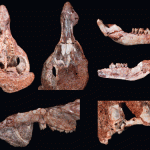Deep inside a volcanic lava tube in the Canary Islands, off the northwestern coast of Africa, lives a newly discovered cave crustacean called Speleonectes atlantida.
Scuba-clad researchers discovered the blind centipede-like species two years ago in the interior of the 1,400-metre-long Tunnel of Atlantis, the longest undersea lava tube in the world. Located on the island of Lanzarote, the tunnel was formed from solidified lava when the Monte Corona volcano erupted there 20,000 years ago.
An international team of researchers, including biologists from Texas A&M University in the US, reported the finding last year. The crustaceans, which belong to a group of more than 20 tunnel-dwelling species called remipedes, measure around a centimetre long and are equipped with long antennae and sensitive hairs to help them navigate their pitch-black surroundings. Powerful limbs on their head grasp prey, including cave shrimp twice their size. Although S. atlantida is physically similar to S. ondinae, the only other remipede known to inhabit the Corona tunnel, the researchers distinguished the new creature in part by its faster swimming abilities. DNA comparisons confirmed the distinction.
The majority of remipedes are found in marine cave systems in the Caribbean Sea, thousands of kilometres west of the Canaries. It’s unlikely that the crustaceans could have swum those distances to populate far-flung regions. Their common ancestor, says the study’s lead author, Stefan Koenemann of the University of Veterinary Medicine in Hannover, Germany, is believed to date back 200 million years, before the continental plates drifted apart, forming the Atlantic Ocean and separating different populations. Eight new remipede species discovered on Caribbean dives still await description, Koenemann says.







